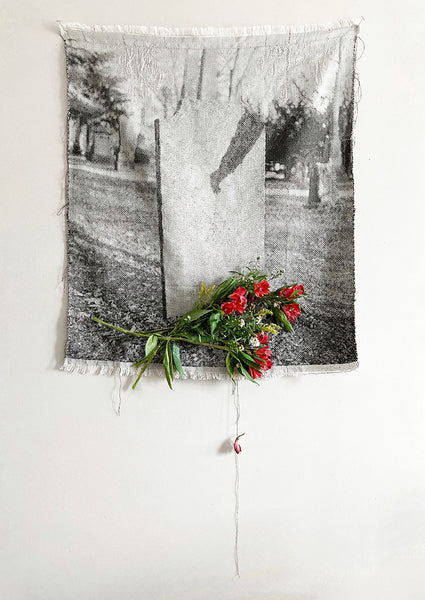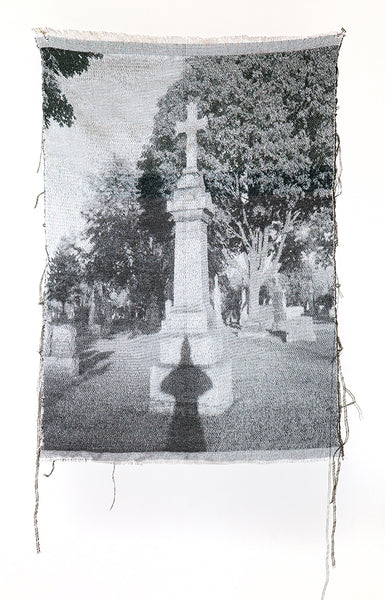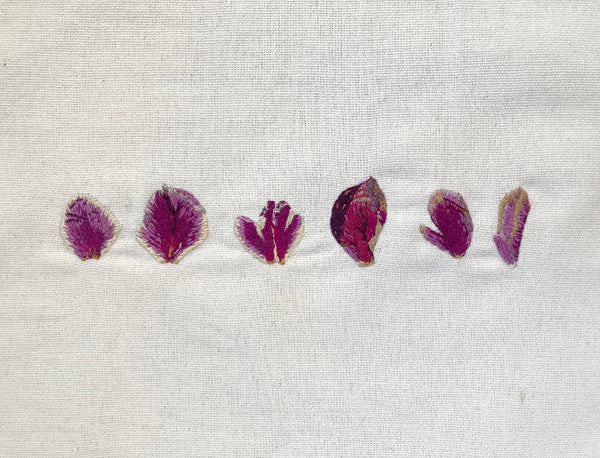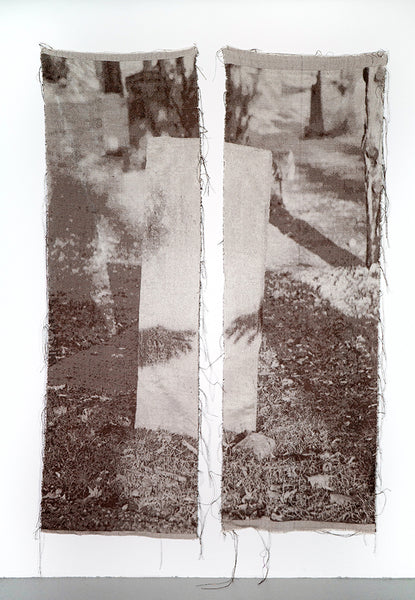Burke Residency 31: Ailene de Vries
•Posted on February 17 2024
AILENE: My name is Ailene - I grew up surrounded by farmland in Ontario, Canada. I experienced extreme seasonal shifts, with rotten tomato smell and 2 o’clock thunderstorms during the summer and snow-in school days in the winter. The landscape around me was always so vivid, and that’s why a lot of my work is a reflection of my childhood environment. Since my world was small growing up, I turned inward for adventure and creative play. It became natural for me to collaborate with my environment, making shapes in the frost and tying dandelions together. I still find myself processing the world in the same way, by weaving, sewing, and shaping materials in order to build memories and play with themes of botany, daughterhood, and grief.

A: I attended a small, private school that ran from grades K-12. My mom was the art teacher for nearly every grade. I watched her closely as she solved problems creatively and successfully communicated to all ages through different projects. My mom encouraged creativity in a variety of ways and over time, I learned to do the same. As a kid, I was able to buy myself an ipod shuffle by selling jewelry I made in my bedroom after school. I was known by my mom as the kid whose room was the funniest to vacuum since she mostly heard all the beads I left on the ground go crunch crunch crunch ping ping ping through the vacuum hose. At highschool graduation, there were these awards that you could receive for academic excellence. My mom awarded me the one she always got to hand out - the ‘art award’.
After highschool, I pursued a degree in Fine Arts at Toronto Metropolitan University at the school of Image Arts. This is where I learned darkroom processes, like the cyanotype that I still utilize in my work. A lot of the skills I learned here I have carried with me–image making, creative writing, historical processes. I was lucky to have had professors that encouraged my creativity and allowed me the space to get messy and make mistakes in order to grow artistically.
A year after graduating from TMU, I moved to Chicago to begin a Masters in Visual and Critical Studies. I had every intention of expanding my critical writing skills, but it wasn’t until I was at the school that I realized a true kinship with the fibers department. Once I secured a spot as a research assistant at the Textile Resource Center at the School of the Art Institute of Chicago, I was welcomed with open arms by those with fiber expertise. I began to take mostly fiber arts courses. I felt like a kid again making jewelry on the floor of my bedroom. I had no idea how much I missed working with my hands.

E: You work with a number of mediums - do you have any favorites to work and create with?
A: There are some projects that I find difficult to explore in one medium alone, and that is why I find myself working within several forms. For example, In 2018, I began a lens-based project within a Toronto graveyard. Using a twin-lens camera, the construction allowed me to stand upright and interact with my shadow. I would look down towards my waist where the viewfinder was and create a frame in which I could dance when I looked up and met my shadow. This was my choreography every time I would visit a graveyard over the next two years. My shadow would jump from stone to stone, casting body onto unfamiliar names.
Through this process, I was met with a heavy limitation: a dissonance between the two-dimensional medium and my emotions. The grief that I had been dancing with did not feel like something that could be captured in order to be flattened. T’ai Smith, an artist and writer, argues that photography operates in a two-dimensional form, while woven structures are three-dimensional; sculptural. Smith states that the form in which these mediums operate, establishes how we interact with them through sight or touch.
When granted access to a TC2 jacquard loom in 2020, it was through the weaving of these photographs that I was able to place body & shadow back into the final product. I could mimic the movement of myself holding a camera at my waist by now holding a shuttle and throwing it back and forth. I followed the pattern of the weave as I had previously followed my shadow as the sun set behind me. My choreography continued in a new form, building an image, not capturing it.

E: Where do you find the materials that you use in your art? Have you ever stumbled across a flower or a color that sparked an idea?
A: Funnily enough (or more like insanely, enough), I have genuinely been stopped in my tracks by flowers since I was little. There was this one peony in particular that absolutely stunned me in 2020–encouraging me to begin the process of taking it apart, pressing each petal individually, and then embroidering every single petal. I worked with this flower for months, until I was inspired to create a ‘petal poem’. When all the petals are embroidered and layed out in panels, they mimic language.


E: I hear that you're an avid small business supporter and collaborator - you've worked with a number of independent businesses in Long Beach! Can you share more about those experiences and the importance of supporting local small businesses?
A: When I moved to California in 2021, I reached out to 3 women, formerly on 1st street next door to Burke, to see if I could be part of their creative team. They welcomed me with open arms and sent me home with quilt work on the first day of meeting them. I was moved by how welcoming and comfortable it felt to be part of the 1st street community. Since then, I’ve offered workshops in Long Beach, participated in multiple street markets, and helped other small businesses achieve their creative goals. I also sell some goods in Vida Plant shop (inside Good Time) in the Zaferia district & played a big part in helping the new restaurant, Mangette, fulfill their textile dreams.
I’ve always held community and creativity at the center of all things I do and I'm stoked to continue to be a part of the Long Beach community.

E: What do you wish more people knew or understood about working with natural materials or about fiber art?
A: In a nutshell, fiber art has the ability to speak to histories and cultures around the world. It’s through textiles that we come to know others and connect with communities. We are fully embraced by textiles everyday, using them as a way to promote self identity. Whether we are aware of it or not, textiles hold us, stop us in our tracks, spark conversations, build warmth, and cool you down. We share our clothes, we pass them forward and down. For me, textile art is a wonderful way to be slow. In a world where I’m constantly forced to flow at the pace of capitalism, especially as an artist, being in a forward fold over an embroidery piece brings me back down to earth.
A lot of people use the word ‘craft’ in connection to needlework or fiber arts. Women have often been associated with this term, like my grandmother and her mother before that. It is a history in which I feel generationally connected, and am so happy to share it to others moving forward.

E: How can people find you and support your work (besides at Burke Mercantile, of course!)?
A: You can find me online here and on instagram as @ailene.devries. I’m often popping up at different locations, so follow me on instagram for local workshops and creative updates. Online shop is coming soon as well! Stay tuned.
Comments
0 Comments
Leave a Comment